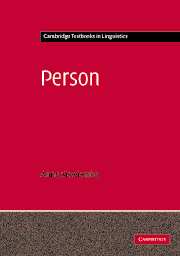Book contents
- Frontmatter
- Contents
- List of figures
- List of tables
- Preface
- List of abbreviations
- 1 Introduction
- 2 The typology of person forms
- 3 The structure of person paradigms
- 4 Person agreement
- 5 The function of person forms
- 6 Person forms and social deixis
- 7 Person forms in a diachronic perspective
- Appendix 1 List of languages in the sample by macro-area
- Appendix 2 Genetic classification of languages cited in the text
- References
- Author index
- Language index
- Subject index
3 - The structure of person paradigms
Published online by Cambridge University Press: 05 June 2012
- Frontmatter
- Contents
- List of figures
- List of tables
- Preface
- List of abbreviations
- 1 Introduction
- 2 The typology of person forms
- 3 The structure of person paradigms
- 4 Person agreement
- 5 The function of person forms
- 6 Person forms and social deixis
- 7 Person forms in a diachronic perspective
- Appendix 1 List of languages in the sample by macro-area
- Appendix 2 Genetic classification of languages cited in the text
- References
- Author index
- Language index
- Subject index
Summary
In chapter 2 we looked at the major factors underlying the existence of different types of person markers. We concentrated on distinct types of paradigms of person markers as a whole, totally ignoring any differences in the internal structure of paradigms. Now it is time to shift the perspective and consider the type of variation found within person paradigms.
Contrary to what may be supposed, the person paradigms found cross-linguistically differ extensively. By way of illustration, Cysouw (2000) found 98 different paradigmatic structures among the 265 person paradigms that he analysed. This high degree of variation is primarily a reflection of the type of grammatical distinctions in addition to person encoded in the paradigm and of how they are distributed. However, it is also to some extent dependent on the type of assumptions made about paradigmatic structure. The two most common grammatical distinctions encoded together with person are number and gender. Number is by far the more common of the two, and also, in its interaction with person, the more complex. It has therefore constituted the basis of the existing cross-linguistic investigations of person paradigms, most notably those of Forchheimer (1953), Ingram (1978), Greenberg (1988, 1993), and most recently Cysouw (2000). There have been no parallel wide-scale cross-linguistic studies on gender in person paradigms but much is known about the issue from the works of Greenberg (1978), Corbett (1991) and Nichols (1992), among others. In our discussion we will be drawing heavily on the insights stemming from the above investigations.
- Type
- Chapter
- Information
- Person , pp. 75 - 119Publisher: Cambridge University PressPrint publication year: 2004



